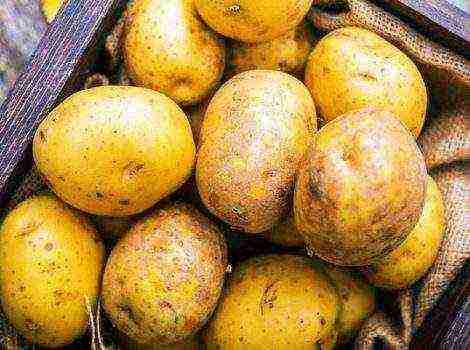Content
- 1 The best varieties of cauliflower
- 2 Description of varieties of early cauliflower
- 3 Growing mid-season varieties
- 4 Planting late cauliflower
- 5 Cauliflower: cultural history, plant features, composition and methods of application
- 6 How to choose the right cauliflower variety for different regions
- 7 The best varieties of cauliflower for different regions: ripening time, description and other characteristics
- 8 What else do gardeners write about cauliflower
Cauliflower is highly valued for its vitamin composition and excellent taste. Novice gardeners are advised to familiarize themselves with the description of all varieties of this crop in order to choose the right vegetables for cultivation in their gardens, taking into account the climate and other external factors.
The best varieties of cauliflower
In this article, a selection of the best crop varieties has been made, each of which has its own advantages. Everyone will be able to choose options for the garden, depending on their preferences. Here are the most delicious varieties, and the earliest, and the most productive.
The quality of agricultural technology makes adjustments to the taste and fertility of cauliflower, therefore, when caring for a garden bed, you should not ignore the basic rules:
- watering;
- top dressing;
- loosening and weeding;
- treatment.
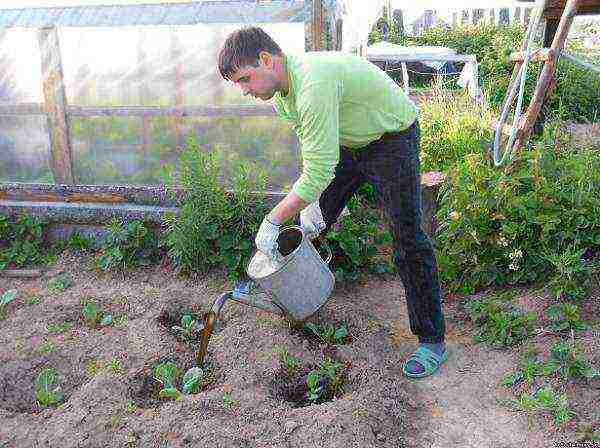 Cauliflower dressing
Cauliflower dressing
It is also important to collect cabbage in a timely manner, since an overripe vegetable or green one does not possess either full valuable qualities or an ideal taste.
In order to harvest the crop throughout the entire summer period, it is recommended to plant varieties with different ripening periods on the site. Then you can enjoy the different tastes of the vegetable and make preparations for the winter.
Cauliflower is considered capricious, but the selected best varieties are resistant to adverse weather conditions, typical diseases, and have excellent taste. With proper agricultural technology, gardeners are always gifted with a generous harvest. Vegetables are used both fresh and for winter preparations. With a long shelf life, they do not lose their taste and market characteristics.
Description of varieties of early cauliflower
Summer resident
The plant has a long fruiting period, the ripening period begins 80-100 days after the transfer of seedlings to the garden. White round head with a slight flattening weighs up to 1 kg. The chemical composition of the vegetable contains a high level of sugar and ascorbic acid, due to which the inflorescence has an interesting taste. The leaves cover the forming head from the scorching sun rays, which allows you to get clean fruits. The size of the summer resident variety is small, so the planting density is 3-5 plants per 1 m2 (the distance between the bushes is 50 cm). The transfer of seedlings to the garden is planned for the end of May - beginning of June. The vegetable perfectly tolerates transportation, retains its valuable properties for a long time if the storage conditions are observed.
Snowball
Cabbage fully justifies its name, mature inflorescences are snow-white in color, although the size is small.The weight of one copy does not exceed 850 grams. High yields are achieved due to dense planting, because the bush is compact, requiring no space for branching. The best variety among early maturing varieties has long been popular among gardeners. The lion's share of this success lies in the plant's resistance to typical diseases. A quick ripening period allows you to get two harvests per season in the black earth zone, from the moment of planting the seedlings to full maturation, no more than 60-65 days pass. Saplings quickly take root in a new place, ripen amicably... Seedling holes are arranged according to the scheme: 50x50, 50x70 cm.
Movir
A hybrid resistant to cold and high temperatures, which, due to its fast ripening period, allows you to take 2 crops per season even in central Russia. Rounded or rounded-flattened inflorescence is white, sometimes with a creamy tint. Weight - from 500 to 1200 grams. The plant cannot boast of a special immunity to diseases and pests, but the taste of the vegetable will pleasantly surprise even a gourmet. When planting seeds, a friendly germination is noted. Fruits can be safely obtained in June, if sowing is done in the second half of February, and the transferred seedlings are covered with a film, protecting them from possible spring frosts. The location of the holes in the garden is planned with an interval of 50 cm in the row and from 60 cm in the aisle, the transfer of seedlings is planned for the period from May 25 to June 10. The plant responds well to nitrogen-potassium fertilizers and other fertilizing.
Express
The inflorescence of white color with a yellowish tinge occupies a leading position in taste among early maturing (the growing season does not exceed 62 days). Dense planting of compact plants (the interval between bushes is 25-35 cm, row spacing 60-70 cm) allows you to take a good harvest, given that the weight of the head does not exceed half a kilogram. Cabbage is vulnerable to pests, but it is resistant to no less dangerous bacteriosis. Preventive treatments and regular weeding will help prevent the invasion of parasites. The transfer of seedlings to the garden is planned for the beginning of May. A film shelter will create protection from possible night frosts.
Growing mid-season varieties
Goat dereza
A compact, upright plant with a white head that has a yellowish and sometimes reddish tint. The inflorescence weight reaches 800 grams, however, with proper agricultural technology, it is possible to grow heads over 2 kg. After planting the seedlings, the fruits ripen in 53-70 days. Seedlings are distinguished by good germination and friendly development. Shoots can be planted both in spring (second half of April) and in summer (until mid-July). Seedling holes are planned according to the scheme: 4 plants per 1 m2. Dereza cabbage is very demanding on the composition of the soil, therefore, when cultivating a crop, it is necessary to fertilize the garden bed and feed the bushes.
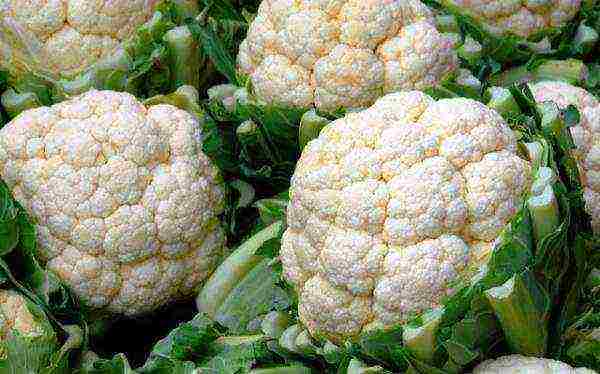 Dereza goat cabbage
Dereza goat cabbage
Flora blanca
The shoots planted in the garden mature in 109-112 days. The inflorescences have a rounded, slightly flattened shape of white with a cream shade. The weight of an average-sized specimen reaches 1.2 kg. The fruit is well covered with leaves, which protects it from the scorching sun rays, which can provoke the formation of dark spots and bitterness in taste. Both germination and ripening occur together, so the harvest does not stretch for a long time. The holes for seedlings are lined up according to the scheme: 50x50, 50x70 cm. Cabbage is tolerant to bacteriosis and frost; it retains its qualities for a long time with proper storage.
White beauty
Refers to a high-yielding species due to the large round head of the white color. In addition, the plant has a quick ripening period, signs of ripeness are observed 55-65 days after planting seedlings on an open bed. The inflorescence weight reaches 800-1200 grams. A feature of the culture is considered to be low resistance to temperature extremes, pests. It is recommended to cover the transferred seedlings with film material, to carry out preventive treatments against parasites in a timely manner. Cabbage retains well its dense structure and valuable properties during transportation and storage. Even freezing does not spoil the presentation.
Planting late cauliflower
Cortez
Among the late-ripening varieties, this variety is considered the most productive. The credit for this belongs to breeders who have developed a hybrid resistant to diseases and adverse weather conditions. Due to the formation of large inflorescences (weight from 2 to 3 kg), the plant needs regular soil fertilization. Large leaves create shading for the head, which makes the cabbage withstand heat. Vegetables are harvested 75-80 days after the transfer of seedlings to an open bed. Young shoots, although capricious, quickly adapt to the new environment. The holes are lined up according to the scheme: the interval between the bushes is at least 70 cm, the row spacing is from 80 cm.
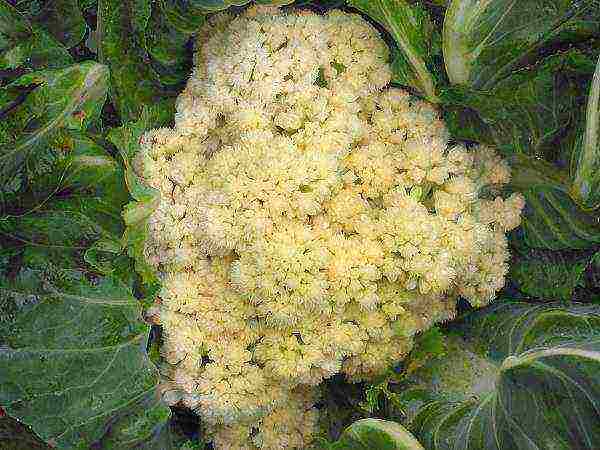 Cortez variety
Cortez variety
Amerigo
Snow-white massive heads ripen 74-80 days after transferring seedlings to open ground. One copy weighs 2-2.5 kg. Unlike other varieties, Amerigo has good immunity, which allows it to resist viral infections and pests. The heads can ripen until the very frost, cold resistance allows you to maintain marketable qualities and delicate taste. Intensive growth requires regular feeding. A feature of the variety is considered to be large leaves, which create shading for the inflorescences, saving them from the scorching sunlight. The transfer of seedlings to the garden is planned for the second half of May-early June. The holes are lined up according to the scheme: the interval between the bushes is 70-80 cm, the row spacing is 70 cm.
Growing cauliflower requires a little more attention and effort as the plant is less immune to disease and pests. But how nice it is to remove beautiful inflorescences from the beds and delight loved ones with delicious culinary dishes or winter preparations.
Cauliflower is one of the best representatives of a large vegetable family. It has more protein and ascorbic acid than a white-headed relative. It retains nutrients better than tender broccoli. Dishes from it are recommended to be included in the children's and dietary menus. However, cauliflower occupies a very modest place in our summer cottages and backyards. Russian gardeners prefer the usual white cabbage to her. And the super-useful color is still considered exotic, as in the 18th century. Meanwhile, there are many productive and unpretentious varieties of this crop, suitable for regions with different climates. Let's take a look at the most productive ones.
Cauliflower: cultural history, plant features, composition and methods of application
Cauliflower is an annual vegetable crop. The first information about its cultivation dates back to the 11th century. Arabian farmers began to cultivate this type of cabbage, so for a long time it was called Syrian. The progenitor of modern varieties gave medium-sized greenish-white heads, their taste was with bitterness. But even then, healers noticed how useful this vegetable is. The famous scientist Ali ibn Sina (known in Europe as Avicenna) advised his patients to eat cauliflower to promote health in winter.
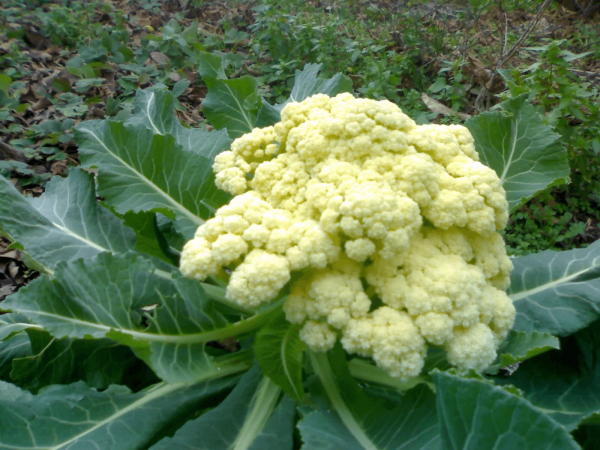
People have been growing cauliflower for ten centuries.
Syrian cabbage hit the tables of Europeans in the 12th century. But it was fully appreciated only three centuries later. Then the first European varieties began to appear. In Russia, cauliflower was a delicacy. It was grown only on the farms of wealthy people. The seeds brought from abroad were very expensive. In addition, the vegetable grew reluctantly under the northern sun. Only when varieties of Russian selection were bred did cauliflower become more popular.
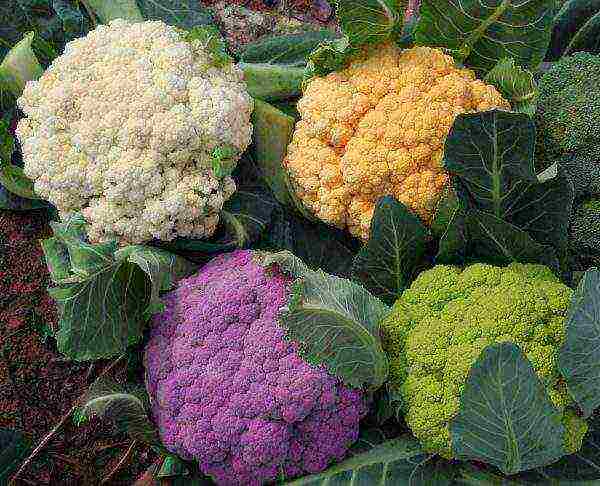
Cauliflower is more popular abroad than in Russia
But even now this delicious and healthy vegetable is inferior to white heads of cabbage in the beds. According to some reports, only 1/100 of the sown area in the gardens of Russians is given to cauliflower. And in European countries it is grown 10 times more.
Description of the plant
Cauliflower has a powerful rod-shaped stem, the length of which can reach 70 cm. The leaf plates are located perpendicular to it or slightly upward. The shape of the bluish-green leaves (oval, feathery, lanceolate) and the size of the petioles (from 5 to 40 cm) depend on the variety. By the time of ripening, a head of undeveloped peduncles is formed at the top of the stem, it is this part that is eaten. Its color can be snow white, cream, yellowish, green or beetroot pink. If the crop is not cut, a flower panicle will rise above the head. From small yellow flowers, after pollination, leguminous fruits are formed, characteristic of all cruciferous plants. Each pod contains up to 10 ball-shaped seeds.
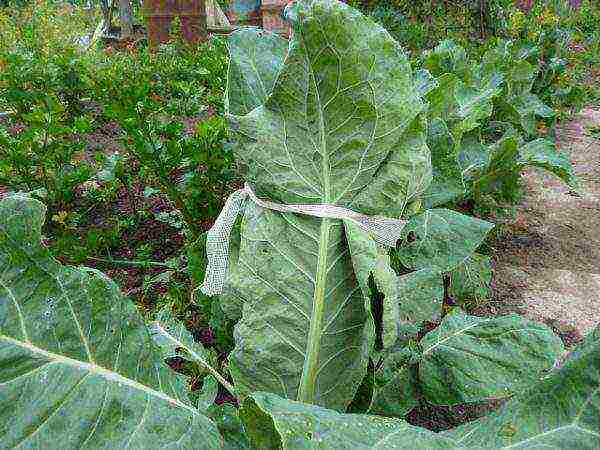
In order for the cauliflower head to develop well, gardeners cover it with leaves.
The roots of cauliflower are located at the surface of the earth, they are weaker and more sensitive than that of white cabbage. Therefore, the culture is more whimsical about the composition of the soil and watering.
Video: the secrets of growing the healthiest cabbage
What is the value of this vegetable, the medicinal use of cauliflower
This vegetable has earned the reputation of being one of the healthiest. Usually, cauliflower is compared to white cabbage. And it ranks first in almost all positions. There are twice as many protein compounds in color, and three times ascorbic acid. And it also contains a lot of carotene, folic acid, thiamine, choline and riboflavin (these are B vitamins), as well as minerals. Among them, the leaders are potassium, zinc, manganese and phosphorus. In addition to the richest chemical composition, cauliflower has one important advantage for dietary nutrition - low calorie content. 100 grams contains only 30 kcal. It is an ideal product for those who are trying to lose weight or follow a healthy diet.
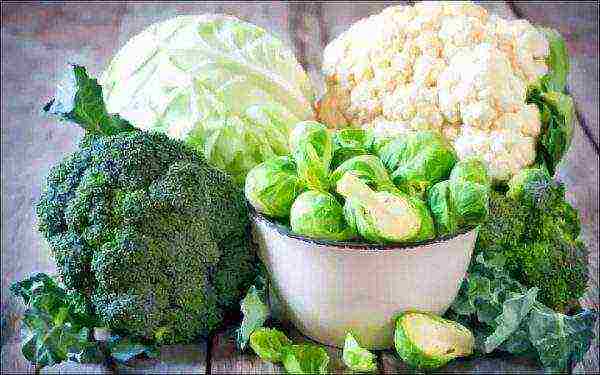
Cauliflower is considered the healthiest compared to other types
Cauliflower is an excellent source of plant fiber. There is a lot of coarse fiber in other types of cabbage, so it is not recommended to include it in the diet for severe diseases of the gastrointestinal tract. But colored fiber is much softer and easier to digest. And it can be used without restrictions in baby and medical food.
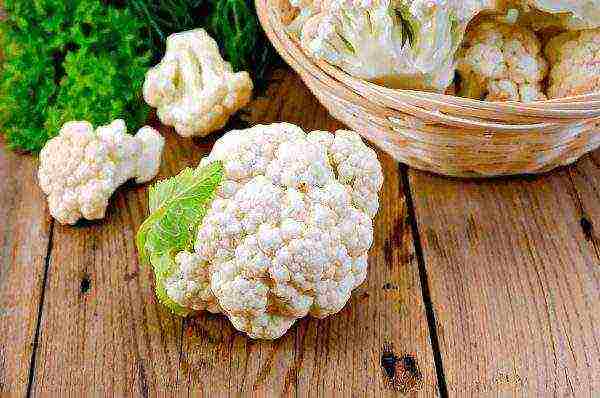
Cauliflower is an indispensable component of dietary nutrition
Doctors advise eating this vegetable more often, especially with a tendency to constipation, problems with the liver and biliary system, cardiovascular pathologies, to increase immunity. In addition, the researchers found that cauliflower was able to inhibit the growth of neoplasms.
The only disease in which cauliflower is harmful is gout. The course of the disease can be negatively affected by the purine compounds contained in the vegetable.
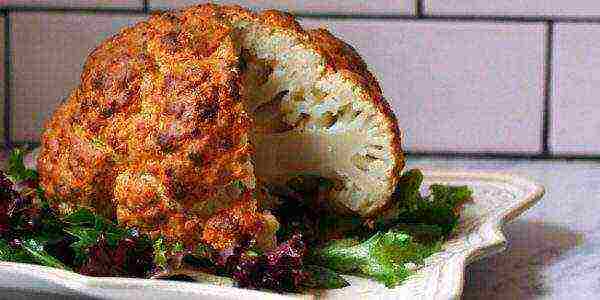
Cauliflower can be used to make many delicious dishes
Video: why you need to fall in love with cauliflower
How to choose the right cauliflower variety for different regions
When choosing cauliflower seeds, be sure to consider the climatic characteristics of your region. For northern latitudes with short and often humid summers (Leningrad Region, Perm Territory, Urals, Siberia), early varieties are suitable. Such vegetables are guaranteed to have time to ripen before the arrival of cold weather. In central Russia, including in the Moscow region, as well as in the Volga region, you can plant cabbage with an average ripening period, however, early cabbage is also a good choice. Gardeners living in the southern regions (Rostov Region, Krasnodar, Stavropol Territory) can grow late varieties. But other varieties of cabbage will delight them with their harvest, if sufficient watering is provided in the heat.
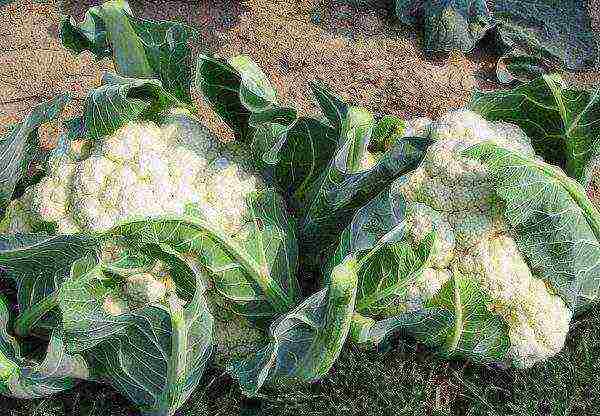
To harvest a good cauliflower crop, you need to choose the right seeds.
In addition, attention should be paid to the origin of the seeds. Untested cabbage of foreign selection may not give the expected result on Russian soil. It is better to choose varieties obtained by domestic vegetable growers. Or those that have already passed experimental tests in Russia, acclimatized and entered into the State Register of Breeding Achievements. For information on varieties of cauliflower see here
More reliable will be seeds directly from a breeder, an experimental farm or a company that itself tests vegetable crops. For example, the Robert variety cauliflower was bred by the specialists of the SeDeK company, which also sells seeds. Or the Snezhana variety, obtained by breeders of the Aelita agricultural company, one of the largest sellers of seeds on the Russian market. Agroholding "Poisk" offers gardeners original seeds of cauliflower, among such varieties - Alpha and Dachnitsa. The breeding firm "Gavrish" owns several varieties included in the State Register: Clara Corals, Purple, Emerald Cup.
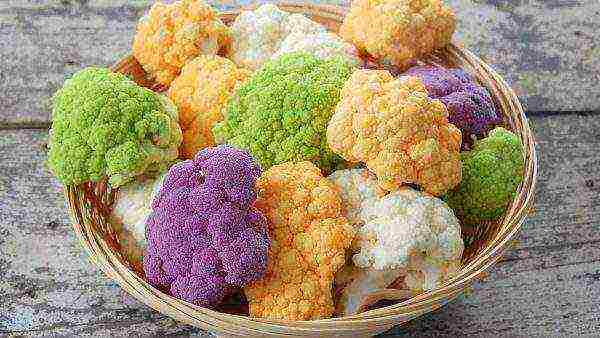
To understand which cabbage you like best, choose seeds of different varieties and producers.
If you're just starting out with cauliflower, don't be limited to one cultivar and seed producer. Plant vegetables with different ripening times from multiple vendors... Even a variety that is suitable for the description can grow poorly in your area. And seeds from a trusted company could, for example, be stored incorrectly, then the germination rate will be low. Only empirically you can understand how high-quality seeds a particular company sells and whether this variety is right for you.
But this does not mean that cabbage seeds from other sellers will definitely be worse. For example, "Russian Garden", if you believe the reviews, also offers high-quality material for crops. The company from St. Petersburg "Sortsemovoshch", which sells under the brand "House of Seeds", offers varieties that are zoned in the Russian north and northwest. You can buy seed and in foreign companies. But then the timing of planting and harvesting, the peculiarities of caring for cabbage must be adjusted taking into account the local climate.
Different types of cabbage are almost impossible to distinguish at the seedling stage. The characteristic signs appear much later. Therefore, when buying planting material, it is easy to make a mistake. This incident happened to me. I planted the Snezhnyi cauliflower variety purchased at the market and waited for its heads to turn white. They increased in size, but stubbornly remained green. And only when yellow flowers appeared on one of them, I realized that I was not growing cauliflower, but broccoli.
The best varieties of cauliflower for different regions: ripening time, description and other characteristics
The State Register of Breeding Achievements of Russia contains more than 150 varieties of cauliflower. The elders of the list are varieties bred by Soviet breeders: Early Gribovskaya (1943), Otechestvennaya (1953), Guarantee (1968), Movir 74 (1969). The most recent, in 2017, added to the register are the French varieties Karnak, Castor, Trident, Flirt, as well as Ormond from the Netherlands and the Russian Butterhead from Gavrish. Judging by how the list is replenished, this culture is still surrounded by the attention of breeders. But in the last century, early varieties were of particular interest, now more than half of the newcomers give a late harvest.
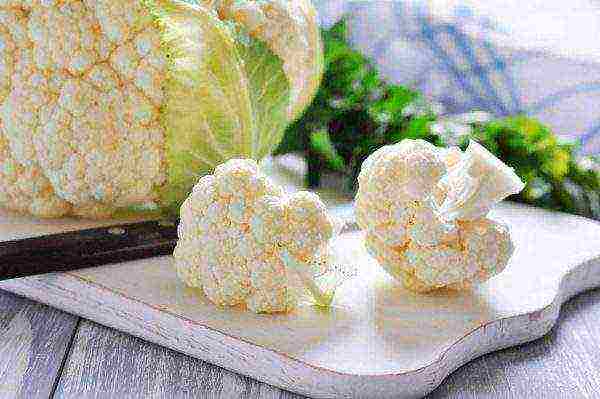
Early varieties of cauliflower are suitable for growing in all regions
As already mentioned, ripening time is the main criterion for choosing a cauliflower variety for growing in a particular area. Let us characterize the representatives of each group of the most popular among Russian gardeners.
Video: an overview of varieties
Early varieties
Cauliflower varieties that yield in a short time form the largest group. There is nothing strange about this. Early vegetables are versatile and can be successfully grown in different climatic zones.And in the northern regions, only early cauliflower can be cultivated in the open field. From sowing seeds to the formation of a full-fledged head, it will take no more than 90 days, and some of the earliest varieties need even less time.
Cauliflower has many enemies. More than once I had to repel the attacks of the cabbage flea, which, without pity, perforates the leaves, bringing them to dryness. Once, in a rainy summer, a colony of slugs settled in one of the heads of cabbage. The rest of the copies were saved. We erected protective structures around the plants: we dug grooves, and then covered them with charcoal mixed with eggshells. The slugs did not overcome the obstacle. But after a few days, strange holes appeared on the cabbage leaves. The pest was not immediately detected. But our dogs suddenly became interested in cabbage. And the next morning, they noisily drove the fat mouse out of the garden.
However, early cabbage has significant drawbacks. Most varieties form not very large heads. And they are not stored very long. True, this problem can be solved by canning or freezing the crop. After defrosting, cauliflower does not lose its presentation or useful properties.
Movir 74
This is one of the most tested early varieties of Russian bred cauliflower. From the appearance of the first leaves to full ripeness, it usually takes about 2 months. In a southern climate, some gardeners harvest two crops of Movir 74. For full development they need space, so they plant seedlings using a 50 x 30 cm scheme. The white or yellowish heads of this cabbage weigh 0.5-1.3 kg each. They are dense and taste good. About 3 kg of cabbage is harvested from each square meter under good conditions.

Movir 74 is one of the oldest Soviet cauliflower varieties, which is still popular today.
This variety tolerates heat and coolness patiently, loves abundant watering, but can be susceptible to bacteriosis.
Movir 2009
The namesake of the Soviet variety was bred and patented by the staff of the All-Russian Institute of Selection and Technology of Horticulture quite recently. Movir 2009 is also distinguished by its early ripening. But his “heads of cabbage” are slightly larger than those of their predecessor. The average weight is 0.9 kg, and the yield is up to 3 kg per square meter. The white cabbage head is slightly covered with gray-green leaves. The pulp is tender and tasty.
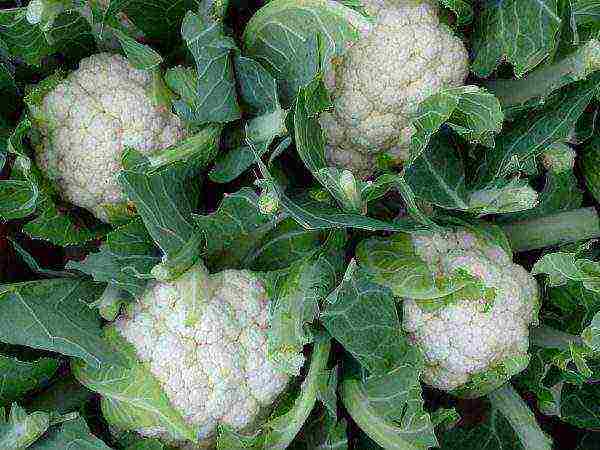
Modern Movir is slightly larger than its predecessor and is less sick
The variety is recommended for growing in personal plots and dachas. The new hybrid is more resistant to disease than Movir 74.
Alpha
This is a relatively new variety of cauliflower, developed jointly by the specialists of the Poisk agrofirm and the All-Russian Research Institute of Vegetable Growing. It is perfect for growing in the Moscow region and more northern regions. No more than 90 days pass from germination to harvest. Large heads are snow-white, slightly flattened, weighing more than 1 kg. The pulp is firm, with a pleasant taste. It is possible to harvest up to 3.5 kg of the crop from one square meter.
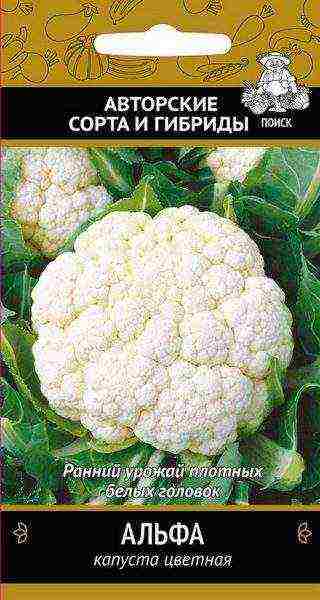
Agrofirm "Poisk" is the author of this variety, so such seeds will be more reliable
Alpha cabbage rarely gets sick. It is great for canning, freezing and fresh consumption.
Express MS
The variety obtained and tested in a private farm took its place in the State Register in 1998. Express MS is recommended for gardeners and farmers for growing in the Central District. It takes about 100 days for cabbage to fully ripen. Creamy white heads are round and small (up to 500 g). The pulp with a high content of vitamin C. The taste of Express MS cabbage was assessed by experts as excellent. In addition, it was noted that this variety is well resistant to bacteriosis.

The Express variety features creamy heads with excellent taste
However, summer residents advise: in the northern regions to grow this cabbage under a film shelter. So the harvest will be higher.
Freedom F1
This cauliflower was obtained by Dutch specialists, but successfully tested in Russia. The hybrid Freedom was included in the State Register in 2010 and classified as medium early varieties. It will take an average of 2.5 months to ripen. Freedom cabbage forms yellowish-white rather large heads, the average weight is 1.8 kg. With good care and a favorable temperature, 3 kg of the crop can be harvested from a square meter.
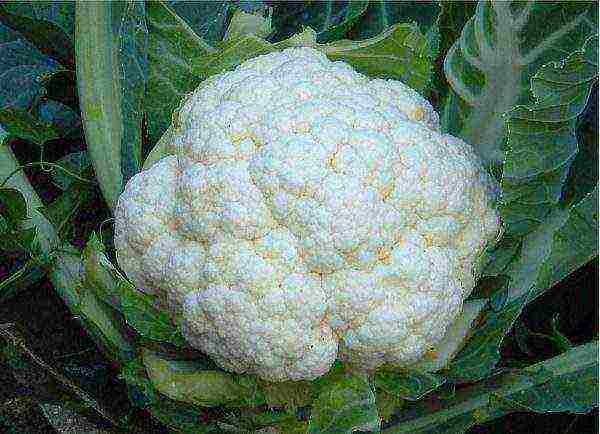
Freedom cauliflower is demanding on growing conditions
Goat Dereza
The variety was bred in the current century by breeders from St. Petersburg (Association "Biotekhnika"). This cabbage takes two months or more to ripen. The Goza-Dereza variety gives heads of medium size (0.8–1 kg), pure white in color. The pulp has a high density and a pleasant taste. The yield is slightly above average - more than 3 kg / sq.m.
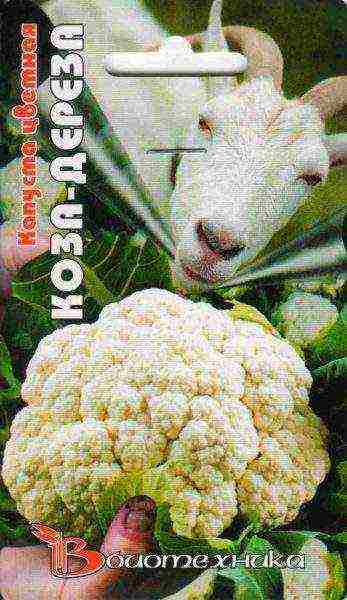
It is better to buy the seeds of this cabbage from the Biotekhnika company, which developed the variety
Vinson
A hybrid from Holland has settled well on Russian soil. Vinson will delight you with tasty and large heads for early cabbage, their average weight is 2 kg. Thanks to this, the yield of the variety is also higher than average, about 6 kg / sq.m. Snow-white cabbage heads ripen in about 2 months. In the southern regions, you can get two harvests of Vinson cabbage per season.
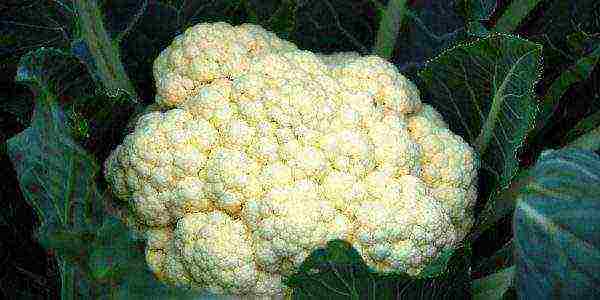
With regular feeding, the Vinson variety produces very large heads of cabbage
Snowball 123
The variety, bred in France, has been grown by Russian gardeners for over 20 years. This hybrid belongs to the early middle. Cabbage heads ripen up to 90-100 days. They should be bright white, round and firm by the time they are harvested. Average weight 1 kg. The taste is excellent.
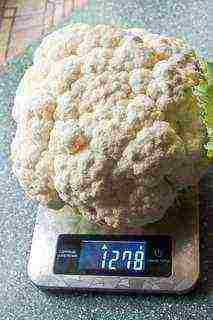
Snowball can produce heads heavier than 1 kg
Snowball 123 provides not the heaviest, but stable yield. This variety is resistant to major cabbage diseases.
Goodman (or Goodman)
The Dutch mid-early variety is well known to Russian vegetable growers. This cauliflower forms small (up to 900 g) yellowish-white heads, but gives a good yield, about 5 kg / m2. Therefore, the variety is recommended for growing not only on personal households, but also on farms. Rapid growth makes it possible to successfully cultivate Goodman cabbage in the Moscow region, central and north-western regions of Russia.
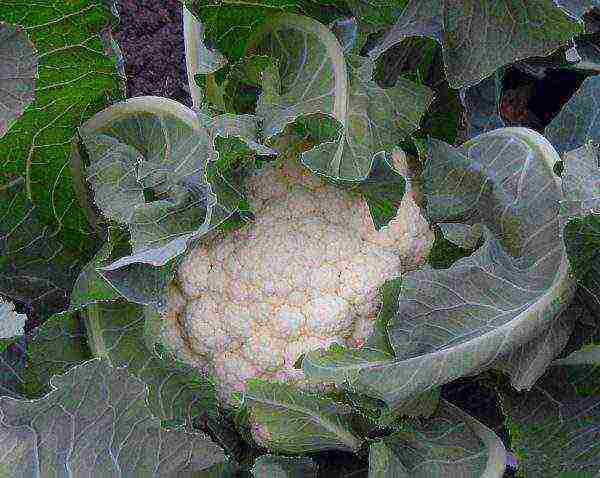
Dutch variety Goodman took root well in Russian soil
Video: growing seedlings of early varieties
Mid-season cauliflower
Medium-ripening cabbage is harvested about 3 months after germination. For the growth and formation of full-fledged heads, these varieties require not only time, but also a sufficiently high temperature, at least +20. Therefore, the colder the summer, the worse the cauliflower will grow. Mid-season varieties are guaranteed to give good results in warm climates in southern Russia. The advantage of these varieties is a longer storage period than earlier varieties. And, by the way, it is among the cabbage of the middle ripening period that there is truly cauliflower: purple and emerald.
Summer resident
The variety was bred and tested in the agrofirm "Poisk" and was recommended in 2004 for cultivation in dachas and farms. The main difference between Dachnitsa cabbage is extended ripening. Harvesting can take place all summer and autumn, it is convenient: it does not have to be stored for a long time. The heads can be of different colors: white, cream or beige. Weight ranges from 600 g to 1 kg. The yield is usually 3 kg per meter.
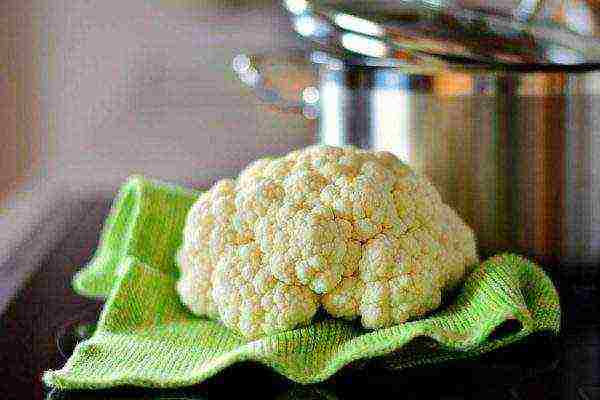
This cabbage can be harvested gradually
The Dachnitsa variety tolerates temperature drops and high humidity well. The plant is not susceptible to disease.
Parisian
Another variety from the Poisk firm. This cabbage gives dense and large (up to 2 kg) snow-white heads. It takes about 4 months from germination to harvest. The Parisianka variety easily tolerates the first autumn cold. This cabbage is perfect for fresh consumption, processing and freezing.

The Parisianka variety is successfully grown both in the south of Siberia and in the Crimea.
Snowball
This variety has not yet been included in the State Register, but has already been noticed by gardeners. For 115–120 days, cabbage forms an elastic, rather large head (average weight 1 kg). Its flesh is firm, pleasant to the taste. The Snow Globe variety safely tolerates a cold snap in autumn. Therefore, there is no need to rush to harvest.

As gardeners write, the Snow Globe cabbage harvest depends on the quality of the seeds
Purple
The Russian variety, the authors of which by the breeding company "Gavrish" and the Research Institute of Vegetable Growing in Protected Ground, appeared in the State Register only 5 years ago. This cabbage is not only tasty, but also very decorative. It forms massive (1.5 kg) purple heads. The yield is 4 kg / sq.m. But in the northern regions, the Purple variety may need shelter.
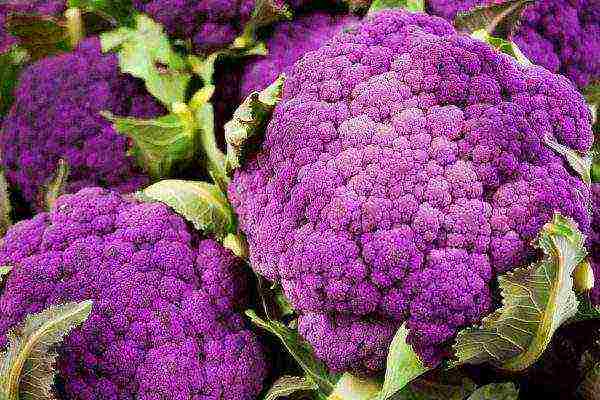
Manufacturer's Purple Cabbage Seeds Do Not Disappoint Gardeners
Purple ball
A new variety of healthy cabbage that will decorate the garden. It was brought out by the specialists of the agrofirm "Aelita". For 120 days, the plant forms edible lilac balls with a small hilly structure, which are framed by bluish-green leaves. The weight of each reaches 900 g. And from each square meter it is possible to harvest about 3 kg.
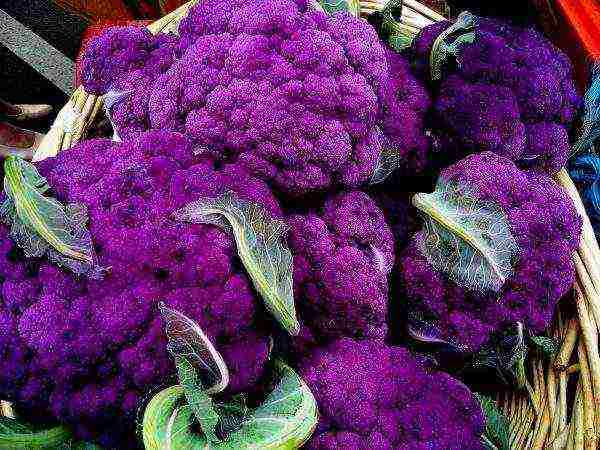
The rich purple color of cabbage is lost during heat treatment
Video: caring for cabbage planted in the ground
Late varieties
It takes 3-4 months for the late varieties of cauliflower to ripen. But the long wait will not be in vain. The harvest most often grows weighty. Each cabbage head pulls one and a half to two kilograms. In addition, they are stored longer than the early varieties.
However, late cauliflower cannot be grown outdoors, not only in the north of Russia, but also in the middle lane. You will need a greenhouse for her. But in the south, seeds of late-ripening varieties are recommended to be sown before winter, right in the garden. Then, with the arrival of spring heat, the cabbage will immediately begin to grow and is guaranteed to ripen in the fall.
Cortez
A hybrid of Dutch origin was acclimatized in Russia. This variety is recommended to grow to summer residents and farmers. It provides a stable yield, and cabbage heads are often larger than average, up to 2 kg and larger. The more fertile the soil, the more significant the harvest will be. Heads of cabbage keep well. Their white, dense flesh remains tasty after freezing.
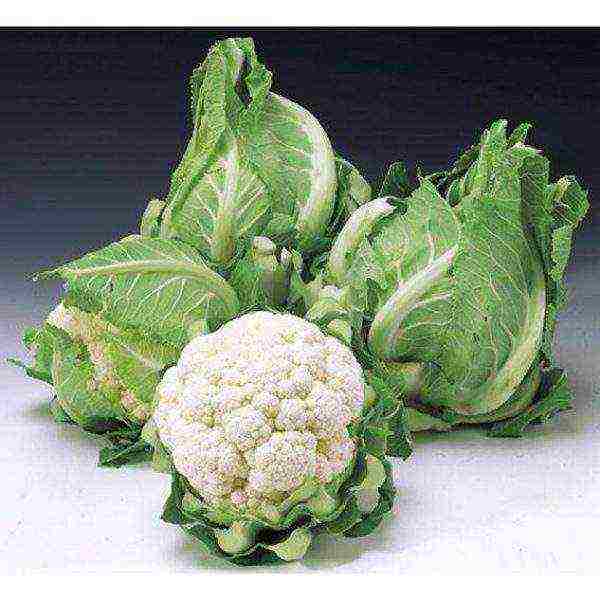
Hybrid Cortez loves fertile soil
But the Cortes variety is picky about the quality of the soil. In areas with poor soil, it is not possible to grow a decent crop if fertilization is not applied.
Amerigo
This is another late variety of cauliflower from Holland. It has been grown in Russian gardens for almost 20 years. The experts gave the highest rating to the taste of Amerigo. In addition, its sugar-white heads grow to a considerable size. The average weight is one and a half kilograms, and the maximum weight is up to 2.5 kg. From one square meter it is possible to harvest up to 5 kg of Amerigo cauliflower crop. Moreover, there is no need to rush to harvest, this variety tolerates a drop in temperature well.
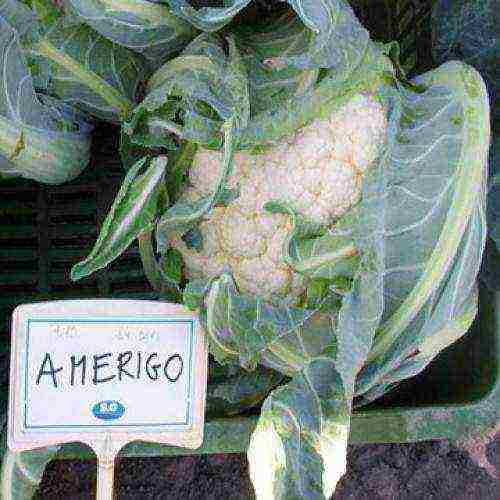
The cold-resistant variety Amerigo produces large heads of cabbage
Agnia
The new Russian variety, bred at the Vavilov Institute, is recommended for growing in the southern regions as a winter crop. This cabbage forms a white head with slight bumps and a delicate texture. Each weighs about one and a half kilograms.
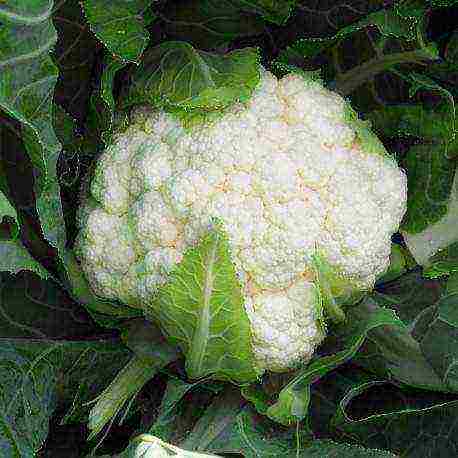
Agnia is a variety recommended for planting in the fall
Green snowdrift
This variety can be considered the newest. It appeared in the State Register only in 2015. So far, the Green Snowdrift has not gained great popularity, but it is worth paying attention to those who love beautiful vegetables. This variety has a pale green head framed and slightly covered with darker leaves. The yield is low (just over 2 kg / sq.m), but the taste of the cabbage is exquisite, and the properties are dietary.
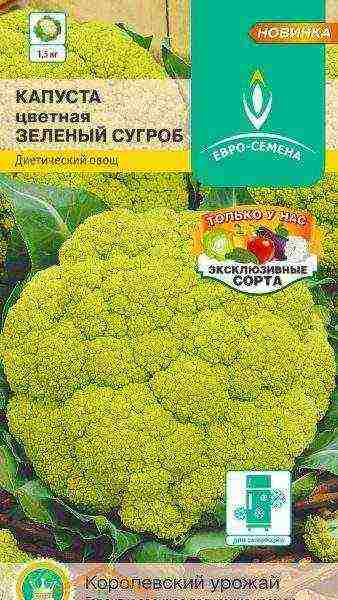
The late Green Snowdrift variety has just begun to gain fans
Clara's corals
Another newcomer to the State Register is worthy of the attention of lovers of unusual plants. The variety was bred by the breeders of the "Gavrish" company. This is a late cabbage with miniature (their weight is only 250 g) heads of a bright purple-burgundy color, surrounded by light green leaves. That is, Clara's Corals are an edible flower. The taste, according to experts, is excellent. Of course, farmers will not grow such an unproductive exoticism. But for the soul and beauty - this is a godsend.
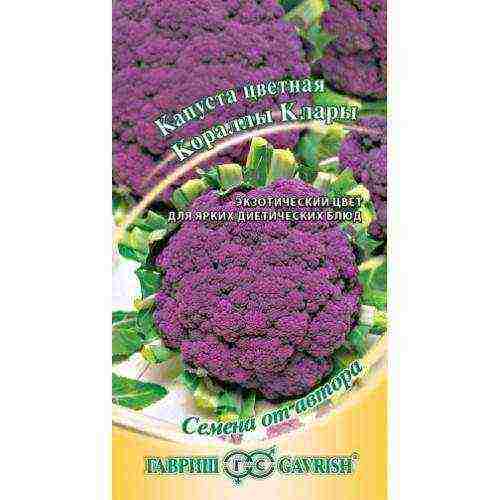
The coral novelty from the Gavrish firm has just recently appeared on the market
Video: a secret that will increase the yield of cauliflower
What else do gardeners write about cauliflower
Cauliflower is a delicious vegetable ideal for a diet. It will be especially useful if grown in its own garden. However, amateur gardeners do not always cope with this crop. Success depends on many factors. One of the most important is the correct choice of the variety. For example, not all are suitable for cultivation in cool climates. In addition, you need to pay attention to the company that produces the seeds. The best producers have their own experimental farms, where they grow their own varieties. And, of course, you need to follow agricultural techniques. Then the cauliflower will thank you for taking care of an excellent harvest.
I am a philologist by education. My hobbies are reading, traveling, caring for my garden and pets. Therefore, much of what I am writing about is not theory at all, but a practice I have gone through personally. Rate the article:
(1 vote, average: 5 out of 5)
 Various varieties of cauliflower are a real gift for advocates of healthy nutrition, combining excellent benefits with a pleasant taste. It is from this “product” that you can prepare those wonderful dishes that the Italians call the word “aldente” - which retain all the useful properties after cooking. For vegetable lovers, it is important from the many types to choose the right one that is best suited for future use.
Various varieties of cauliflower are a real gift for advocates of healthy nutrition, combining excellent benefits with a pleasant taste. It is from this “product” that you can prepare those wonderful dishes that the Italians call the word “aldente” - which retain all the useful properties after cooking. For vegetable lovers, it is important from the many types to choose the right one that is best suited for future use.
Principles for the selection of varieties
The best varieties of cauliflower give good yields in almost any climatic zone, although the gardener must be able to correctly assess the possibilities of agricultural farming in his region. Given the special "attachment" of cauliflower to heat, it becomes clear that its varieties for the middle lane and southern regions can be very different. In the climatic region of Siberia, it will be extremely difficult to grow any types of colored vegetables in open field conditions.
In order to choose the right seeds for planting, it is worth considering several fundamental points: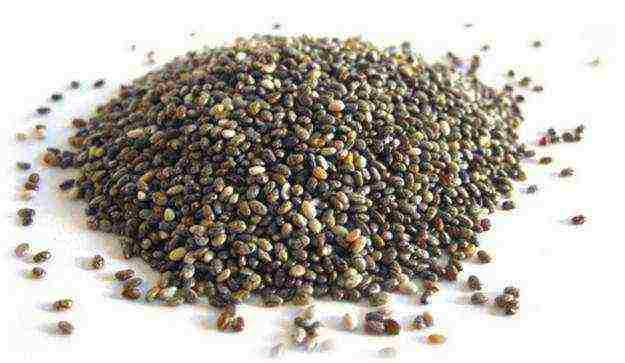
- The best seeds and F1 hybrids of cauliflower are the selection of the planting region. In particular, the species intended for the southern areas will find it much harder to take root in the climate of central Russia.
- Varieties of foreign selection of cauliflower must be corrected in terms of planting and ripening for your region.
- Choose a seed that is resistant to weather problems and fluctuations in soil moisture, capable of actively bearing fruit, regardless of the acidity level (if possible) and the types of soil.
- The seeds should grow plants that are as resistant to diseases and pests as possible.
- For the possibility of selection in your area, choose varietal seeds. F1 hybrids can be distinguished by high yields, quick ripening periods, but the “offspring” from them usually loses all the best qualities of the “parents”.
- To guarantee a harvest in one season, it is better to plant several types of cauliflower with different ripening times.
For regions with short, often rainy summers, early ripening varieties are optimal. Inhabitants of warm regions can choose seeds of more capricious, but fruitful and very tasty mid- and late-ripening varieties of varieties and F1 hybrids.
Multicolor cauliflower can have white, yellow and purple buds with variations in color. Varietal varieties and hybrids of F1 vegetables differ in the size and density of the "head", the shape of the leaf cover, taste, the climate of the initial selection, the possibility of planting in open ground and a number of other features. Most of the characteristics are indicated on the seed packaging, which requires only careful reading.
Ripening classification
The most important is the classification of varieties and hybrids of cauliflower according to the length of the growing season, where there are 3 main groups. In each of them, gardeners have their own "favorites", which delight with a special taste, are perfect for cooking and long-term storage.
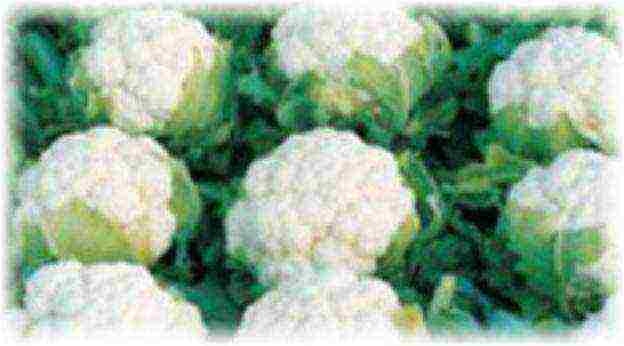 Early maturing cauliflower forms ripe heads in 80-100 days. Ultra-early species “cope” even earlier. Most varieties are distinguished by their low shelf life and small size of "heads" surrounded by short leaves, but they are excellent for cooking in the "aldente" style.
Early maturing cauliflower forms ripe heads in 80-100 days. Ultra-early species “cope” even earlier. Most varieties are distinguished by their low shelf life and small size of "heads" surrounded by short leaves, but they are excellent for cooking in the "aldente" style.
The average ripening period for "colored" varieties is from 100 to 120 days. Heads are formed exclusively when the temperature values of the 20 degrees mark are exceeded. The extended growing season helps to extend the shelf life of the harvested crop.
Species of cauliflower of late formation of the harvest "sit" in the ground for an average of 120-130 days, which makes it impossible to grow them "on the street" in the middle zone of the country and to the north. And, nevertheless, solid yields, large heads of cabbage and good keeping quality are quite an argument for planting such "colored" varieties equally in the south and in greenhouse farms in colder regions. In this case, the easiest way is to choose "tenacious" hybrids, the names of which can be found in the appropriate reference books.
Optimal and recognized varieties
And now it's worth getting to know a little closer with that wonderful cauliflower, which gives guaranteed yields. Of course, with the proper "application of hands" to the care and preservation of plantings.
 Hybrid "Amphora F1"... Romanesco cultivar. The average ripening period is 90 days. Planting seeds for seedlings - mid-April. Carrying out into the ground on the site one month after sowing. Planting with a scheme of 30 x 50 cm. The leaf is gray-green, almost erect. The head is in the form of a dome, with large tubercles, lemon-green, weighing from 350-450 to 800, maximum 1200 g.
Hybrid "Amphora F1"... Romanesco cultivar. The average ripening period is 90 days. Planting seeds for seedlings - mid-April. Carrying out into the ground on the site one month after sowing. Planting with a scheme of 30 x 50 cm. The leaf is gray-green, almost erect. The head is in the form of a dome, with large tubercles, lemon-green, weighing from 350-450 to 800, maximum 1200 g.
96% of the planting material emerges. Productivity 1.5 kg per meter of planting area. Amphora is suitable for aldente and freezing. Especially high in protein, vitamins and minerals.
"Baldo F1". A hybrid of Dutch selection, taking into account Russian farming conditions. March landing for seedlings. On a permanent place of growth "comes out" after 45-50 days, according to the scheme 50 x 50 or 60-70 x 35 cm. With early harvesting, heads of cabbage are removed after 55 days, collection in the middle of summer - after 70 days (in June-August) ... There are options for different regions.
Head "Baldo" very dense, weighing up to 2 kg with a diameter of 15-23 cm. High self-covering ability. The color is snow white. The leaves are velvety with a slight waxy coating.The taste is excellent. The variety calmly survives a slight cold snap and heat. Growth and development stimulants are recommended.
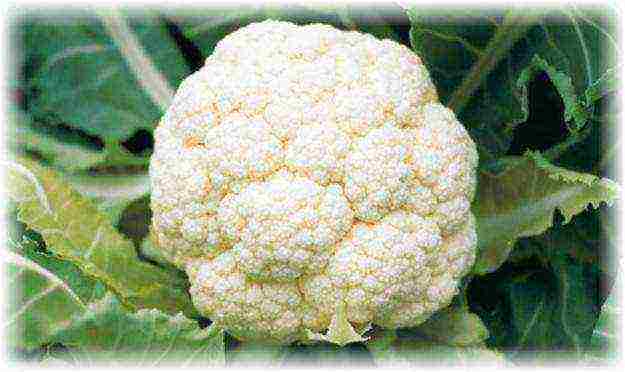 Bora. The growing season is 115 days. Snow-white heads of cabbage of excellent density, not too massive (on average 800 g). Sowing seeds from February to April. Seedlings are ready for 30-35 days. They harvest from May to August, depending on the timing of planting, an average of 2 kg of vegetables per square meter of planting. High commercial quality and versatility. The variety can be prepared in different ways - from "aldente" to standard preservation and freezing.
Bora. The growing season is 115 days. Snow-white heads of cabbage of excellent density, not too massive (on average 800 g). Sowing seeds from February to April. Seedlings are ready for 30-35 days. They harvest from May to August, depending on the timing of planting, an average of 2 kg of vegetables per square meter of planting. High commercial quality and versatility. The variety can be prepared in different ways - from "aldente" to standard preservation and freezing.
Bruce F1 (Prestige). Originally from Holland, resistant to stressful growing conditions. The beginning of planting for seedlings is March. The scheme of planting the Bruce hybrid in open ground 50 x 60 cm. The technical maturing period is 55-60 days. Cleaning dates are spring and early summer or autumn. Heads of cabbage are covered, flat-rounded, inflorescences are light, with a milky color. "Bruce" is gaining weight up to 1.5 kg. Yields reach 4.5 kg per 1 sq. m. High taste and marketability. "Bruce" is attractive for its rapid maturity and complete unpretentiousness.
Hybrid Vinson. A variety of a Dutch breeding company. Cabbage "Vinson" is an erect plant of a powerful type. Sowing on seedlings in mid-April, on garden land - in a month. The layout is 30 by 50 cm. "Vinson" ripens 2 months or a little more after landing on the site. Can be grown until autumn. The high-yielding hybrid yields almost 6 kg of cabbage per square meter.
Due to the excellent self-covering abilities, a milky-white, rounded, smooth, strong head weighing up to 3 kg grows. For a snow-white head of cabbage, the plant should be fed with microelements, especially molybdenum. Vinson can be cooked in the aldente style, any other recipes, or frozen.
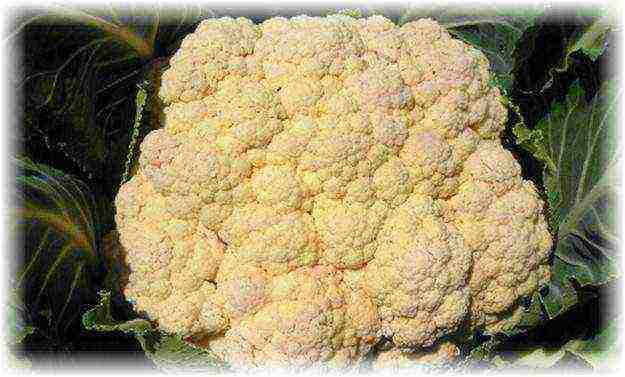 "Summer resident" - a variety that ripens from 80 to 100 days. Sowing for seedlings begins in mid-March. Seedlings love feeding and watering. They are planted in a greenhouse or on the street in the last days of April, early May. The order of arrangement is 35 x 50 cm. Planting varieties "respect" complex care - watering, feeding, weeding and loosening in one day. Gives rounded flattened, medium hilly, fine-grained heads of cabbage weighing from 600 g to 1 kg, white with the lightest light brown tinge. It is recommended to shade the heads by breaking.
"Summer resident" - a variety that ripens from 80 to 100 days. Sowing for seedlings begins in mid-March. Seedlings love feeding and watering. They are planted in a greenhouse or on the street in the last days of April, early May. The order of arrangement is 35 x 50 cm. Planting varieties "respect" complex care - watering, feeding, weeding and loosening in one day. Gives rounded flattened, medium hilly, fine-grained heads of cabbage weighing from 600 g to 1 kg, white with the lightest light brown tinge. It is recommended to shade the heads by breaking.
Variety "Summer resident" resistant to unfavorable weather “surprises”. The volume of harvest per meter of planting area is up to 3 kg. The variety is equally good for aldente, hot dishes and long-term freezing. High sugar content, a lot of vitamin C. Commodity quality is on top.
Incline - a hybrid of the first generation of high taste and yield, especially resistant to diseases. It comes to technical maturity in 3 months. Seeds are sown in March, April. After 35-40 days, the seedlings are determined on the site. The planting scheme is 50 by 30 cm. Harvesting in August and September. The minimum harvest rate from 1 sq. m. - 2 kg.
The weight of flat-rounded, superbly white, dense heads of cabbage reaches 3.5 kg, depending on the stocking density. The heads are completely covered from the scorching rays of the sun. The quality of vegetables is ensured with good watering. Incline is not afraid of cold and high humidity. Grows well in large areas. Perfect for freezing and processing.
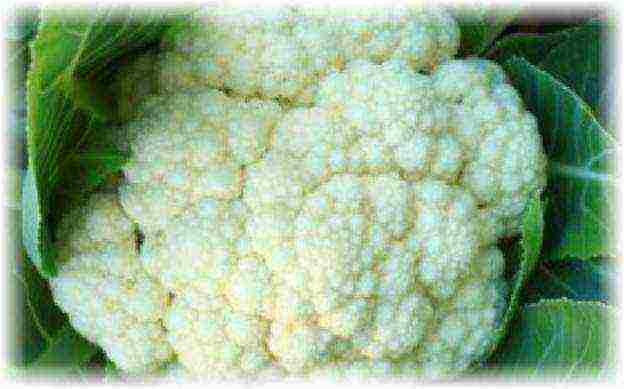 "Goat Dereza". The period of development of the heads depends on the time of disembarkation. When planted in March-April, the heads of cabbage ripen in 57-70 days, from April to June - up to 2 months and a little more, in June-July the vegetable grows a little more than 2 months. For growing seedlings, seed material of the "Goat Dereza" cauliflower variety is planted in March-April. In the garden, no more than 4 bushes are planted per 1 sq. m. according to the scheme 35 by 50 cm. The varieties are harvested in July and August. It is tied up and ripens together, it grows of excellent taste.
"Goat Dereza". The period of development of the heads depends on the time of disembarkation. When planted in March-April, the heads of cabbage ripen in 57-70 days, from April to June - up to 2 months and a little more, in June-July the vegetable grows a little more than 2 months. For growing seedlings, seed material of the "Goat Dereza" cauliflower variety is planted in March-April. In the garden, no more than 4 bushes are planted per 1 sq. m. according to the scheme 35 by 50 cm. The varieties are harvested in July and August. It is tied up and ripens together, it grows of excellent taste.
The density of the fruit is very high, the color is white, without shades. The weight of the heads of the "Goat Dereza" variety is 700-800 g, it can be up to 1 kg. Shade them by breaking the sheets.Excellent taste in aldente preparation, canning and frozen. The variety is cold-resistant. They remove 3 or a little more kilograms per square meter.
Movir-74. F1 hybrid matures up to 105 days, in comfortable weather conditions - in 50-65 days. The seed is planted on seedlings in mid-April, outside in a month, according to the scheme 50 x 30 cm. He is calm about heat and cold. The variety loves watering. The size of the heads of the Movir-74 cabbage depends on the quality of the seeds and the weather - from 11-15 to 23-25 cm in diameter. Weight 400-1400 g. Round, with a slight flattening, type. The surface is hilly, fine-grained. The color is white or slightly yellow. Among the disadvantages is poor resistance to bacteriosis and pests.
Maximum yield "Movir-74" up to 4 kg from 1 sq. m, average - 1.4 kg. You can take 2 crops per season, the main harvest is in July-August. The heads are singing together. Pleasant taste, good option for canning and fresh consumption. The crop is well transported.
 Cauliflower Snowball 123 - cold-resistant mid-early variety with excellent taste and preservation qualities of the product, not susceptible to major diseases. Technical maturity occurs at 78-119 days. Sowing seed - April, May. Sowing scheme in street or greenhouse soil 70 x 40 or 50 cm. Age of seedlings is at least 35 days, but 40 is better. Harvesting of cabbages in July-September.
Cauliflower Snowball 123 - cold-resistant mid-early variety with excellent taste and preservation qualities of the product, not susceptible to major diseases. Technical maturity occurs at 78-119 days. Sowing seed - April, May. Sowing scheme in street or greenhouse soil 70 x 40 or 50 cm. Age of seedlings is at least 35 days, but 40 is better. Harvesting of cabbages in July-September.
Gives "firmly knocked down", rounded-flattened, medium-lumpy, self-closing white heads, weighing from half a kilogram to two. The taste is excellent. Productivity is stable provided timely watering, weeding, loosening and feeding with boron and molybdenum. They remove an average of 2 kg per 1 sq. m, it is really possible to remove up to 4 kg or more. Withstands long-term storage in a frozen state.
Fremont F1. One of the largest representatives of cauliflower created in Holland. Sowing occurs in March, April. The age of the planted seedlings is up to 30 days. The layout is 50 x 30 cm. The timing of the readiness of the heads of cabbage is 75 days from the disembarkation of the seedlings. With early spring cultivation (planting in March or April) - after 88 days. The plant of the variety is powerful, capable of growing in stressful situations. It can be grown from spring to autumn. The hybrid is resistant to major diseases.
The heads are perfectly tied and self-closing. For the snow-white inflorescences "Fremont" is important to feed with complex mineral fertilizers with the inclusion of trace elements. Heads of cabbage are dense, tasty, grow up to 3-5 kg with quality care and water balance. Perfectly cooked, frozen or canned. Productivity from 2 kg per meter of planting area.
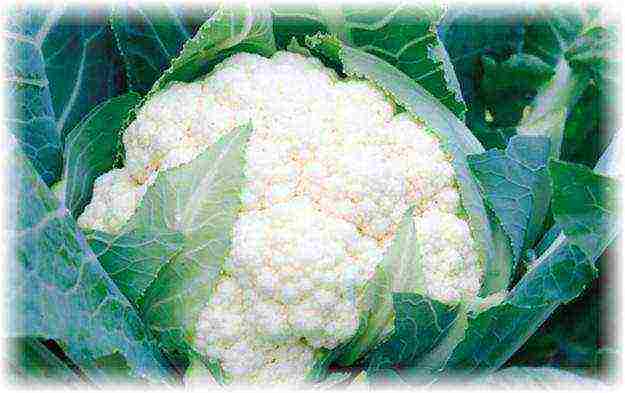 "Freedom F1". Dutch cauliflower, which can be grown from spring to autumn. With early planting of seedlings "Freedom" ripens in 88 days, in conditions of planting from May to August it reaches ripeness in 70-78 days.
"Freedom F1". Dutch cauliflower, which can be grown from spring to autumn. With early planting of seedlings "Freedom" ripens in 88 days, in conditions of planting from May to August it reaches ripeness in 70-78 days.
The seating pattern is 75 by 50 cm. The highest quality of the heads that can self-hide and develop in stressful situations. "Freedom" is easy to care for and clean. The heads ripen up to 5 kg. The Freedom hybrid is suitable for any processing.
The names of some varieties and hybrids are well known to a wide circle of vegetable growers, others are just gaining popularity, and it is worth taking a closer look at them.
The main thing to remember is that the ripening times indicated on the packaging are very conditional. To a greater extent, they are due to the climate of growing cauliflower and the careful attitude towards it.
Cauliflower is more difficult to grow than white cabbage. It is less resistant to climate changes, can often get sick and does not always please with a bountiful harvest. Therefore, before planting, you need to accurately determine the variety that will completely suit the gardener. Cauliflower varieties are very diverse. The differences lie not only in the ripening period or growing method, but also in the size of the heads, the yield, and even the color of the cabbage.
The best early varieties of cauliflower
Cauliflower comes in early, mid-season and late-season. Early cauliflower varieties are fast growing so they can be tasted first of all, but they spoil quickly as they have a delicate texture.
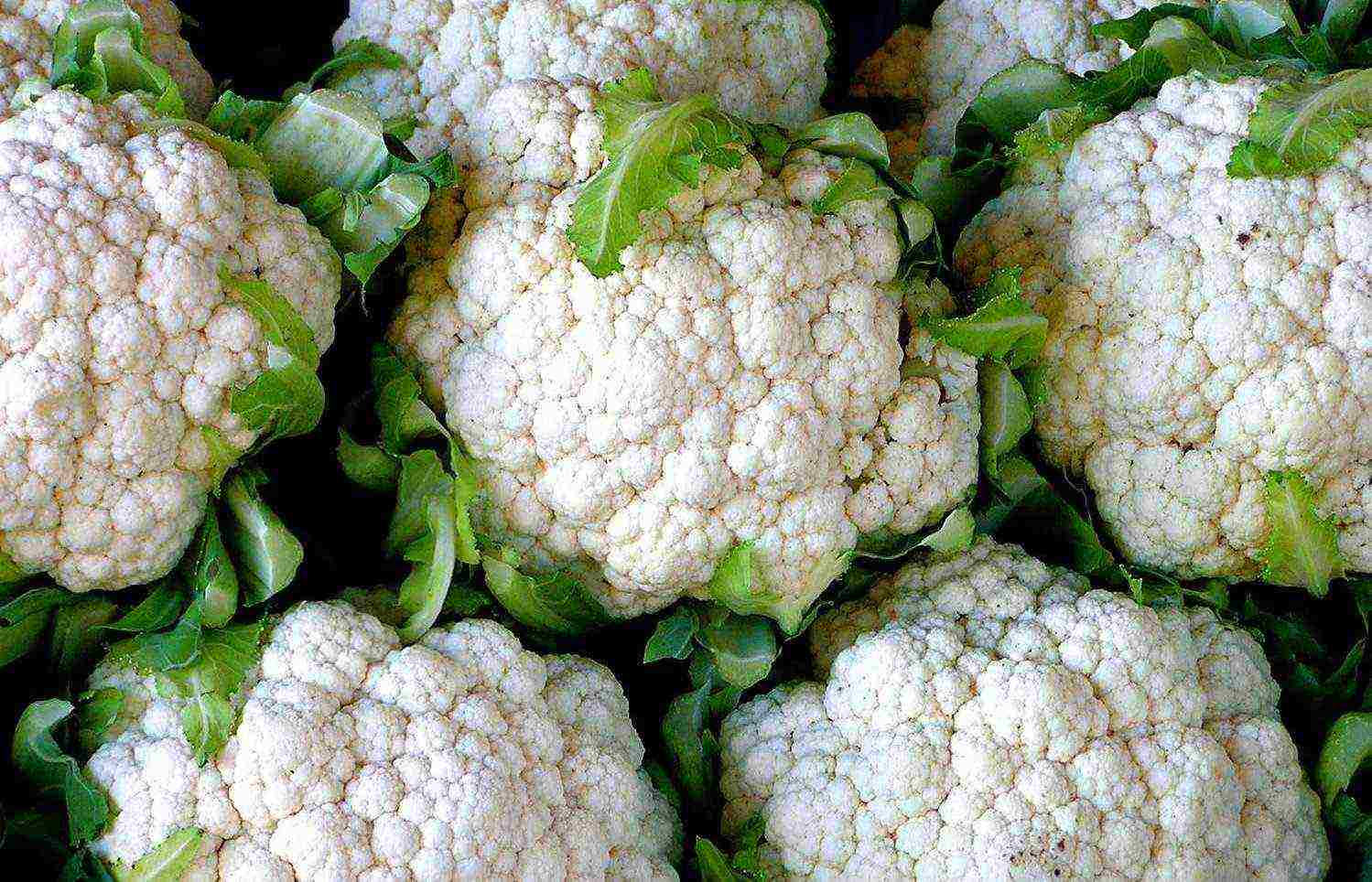
Early varieties of cauliflower
- "Warranty" - an early variety bred for cultivation in the open field. Ripening amicably in 50 days after planting seedlings or in 75-98 days from the moment of emergence. The heads grow small - 300-1000 g. From above, they are protected by covering, developed leaves. The shape of the cabbage is round-flat, the texture is fine-grained, the color is white with a creamy sheen. The taste is pronounced. The yield per square meter is 1.5-3.5 kg. The variety is resistant to long journeys, is not affected by vascular bacteriosis.
- Snowball - French early ripening variety that gives a full-fledged cabbage 90-95 days after germination. The heads are dense, small - 400-1000 g, snow-white in color. The shape is flat-round. The taste is excellent, it is used fresh, preserved, frozen. Productivity per square meter up to 4 kg. Not afraid of cold snaps.
- "Snowball" - very beautiful, lumpy cauliflower. It stands out for the fact that it has stable immunity from many diseases. The heads are snow-white, hence the name, with pronounced tubercles, round-flat in shape. Weight - 650-850 grams. Can be grown in unfavorable conditions, in open and closed ground. Average yield per square meter is 3 kg.
- "Movir 74" - an early variety of cauliflower. From germination to technical ripeness, 85-95 days pass. Grown in open or protected ground. The heads are round-flat, tight, weighing 0.4-1.4 kg. The surface is bumpy, fine-grained, white in color. This cabbage is good in preservation, it tastes good when fresh. Can be transported over long distances, tolerates heat and moderate cold, does not crack. 4 kg of this cabbage are harvested per square meter.
- "Regent" - medium early variety for universal use. From germination to technical ripeness, 100-110 days pass. It is cultivated both indoors and outdoors. There is resistance to disease, drought. The head is not very firm, but this is normal for early cabbage. The shape is round, the color is white, the texture is fine-grained. The average weight is 500-600 g. The yield depends on the care and the place of cultivation (in greenhouses above), from 0.9 to 3.9 kg per square meter.
These are just the best varieties of early-ripening cauliflower. The following varieties are also very popular among gardeners: Express, Goodman F1, Koza Dereza, Alpha, Bolero.
Mid-season varieties
Mid-season cauliflower varieties are an intermediate “point” between early and late ones. In texture, they are closer to the early ones - delicate, sweetish, but already denser, which allows them to be transported to distant markets without any problems. At the same time, mid-season varieties and hybrids are stored for a long time, they are rarely afraid of frost and have a high content of vitamins.

Mid-season cauliflower varieties
- "White beauty" - high-yielding variety - 4-6 kg per square meter. Ripening occurs 65 days after planting the seedlings. Growing is recommended in open ground and not in greenhouses. The heads are large, up to 1.2 kg, white, dense. The main disadvantages are vulnerability to temperature extremes and pests. Advantages - transportability, presentation, long-term storage.
- Flora Blanca Is a mid-season Dutch variety that yields as early as 110 days after germination. There is resistance to autumn cold snaps, bacteriosis. The head is elastic, large, weighing about 1.2 kg, white and yellow. The taste is excellent, it can be used in any form. An average of 2.5 kg of cabbage is harvested per square meter per season.
- "White little head" ripens in 110-120 days. The head is flat-round, white, weighing up to 1.1 kg. Differs in a high content of vitamin C and microelements.It is used in cooking (including baby food), medicine, cosmetology. Has a pleasant taste, resistance to slight frosts. Productivity 4.5 kg per square meter.
Some of the good mid-season cauliflowers are: Bora, Celeste.
The best late varieties of cauliflower
Late varieties of cauliflower contain a lot of nutrients. However, it is possible to grow them in the northern regions only in greenhouses or homemade greenhouses, since they do not have time to ripen before the first frost.

Late varieties of cauliflower
- "Amerigo F1" hybrid giving heads with a mass of 2-2.5 kg. It grows slowly, only 2-2.5 months after planting seedlings, you can try the first harvest. This cabbage has snow-white heads, massive, weighty. Possesses persistent immunity from viral diseases, pests usually do not bother her. The use is universal. Differs in capriciousness in terms of soil, fertilizers, watering. Productivity per square meter 6-8 kg.
- "Asterix F1" - Dutch hybrid, ripening in 125-130 days. It has dark green leaves. The head is white, round, even, weighing up to 900 g. Taste is good. The yield can be up to 2.3 kg per square meter. It is immune to powdery mildew.
- Cortez F1 - one of the most productive hybrids of late cauliflower. Ripens in 75 days from the date of planting seedlings. At least 5 kg of cabbage is harvested from a square meter. The head is dense, white, weighty (2-3 kg), with a high juice content. Ideal for sale, storage. This hybrid survives during the first autumn frosts and temperature changes. Disadvantages: exactingness to soil, fertilizers.
This also includes: "Adler winter 679", "Sochinskaya", "Adler spring".
Unusual varieties of cauliflower
White cauliflower is a classic. It is delicious, beautiful, but simple. For several decades, scientists and breeders have been creating new varieties of cauliflower, with cauliflower, which have an increased amount of certain vitamins (minerals) in the composition. Unusual varieties of cauliflower are described below.
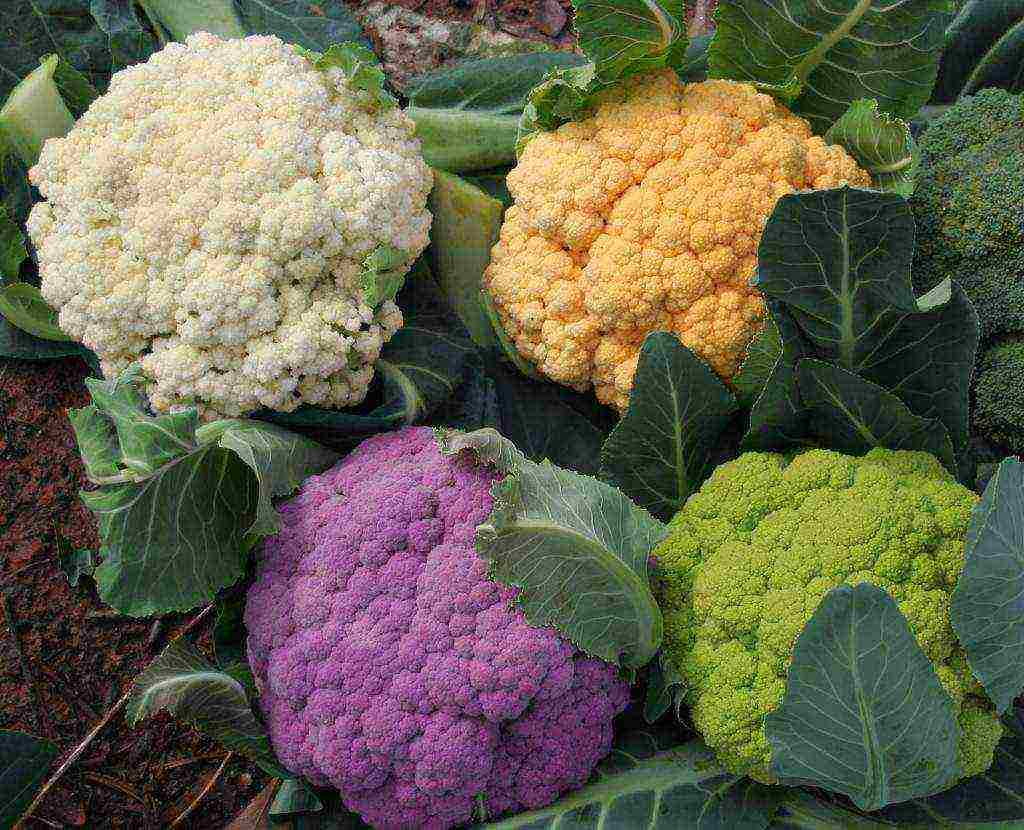
Unusual varieties of cauliflower
- Romanesco - a hybrid of cauliflower and broccoli. It stands out for its striking appearance. Sometimes referred to as "coral cabbage". It looks like a seashell. Inflorescences are pyramidal, yellow-green in color. Heads of cabbage grow together with normal agricultural technology, reaching a mass of 0.5 kg or more.
- "Yarik F1" - mid-season hybrid, ripening 65 days after planting seedlings. The head is yellow-orange, dense, with small tubercles along the surface. The structure is tender, weight - 300-500 g. This cabbage has a high content of beta-carotene. It is used for a variety of fresh dishes, frying, boiling, freezing. With good care, up to 2.5 kg of vegetables are harvested per square meter.
- "Graffiti F1" - mid-season hybrid - when planting seedlings, the crop is harvested in 70-80 days. The leaves are blue-green with a waxy bloom, the head is purple, slightly raised, flat-rounded, taut, with poorly pronounced tubercles. The texture is delicate, weight - 700-1100 g. With proper care, up to 6 kg of cabbage can be harvested from a square meter. The taste is pleasant, contains a lot of anthocyanins. It differs in that it cooks faster than simple cauliflower; with prolonged cooking, the color may change.
- "Rosamund" - German early ripening variety. After sprouting, 110-113 days pass to technical ripeness. The heads are small - 0.6-0.8 kg, dense, of a pleasant appearance - lilac. In terms of the amount of some nutrients, this variety is ahead of other well-known hybrids and varieties of cauliflower. There is immunity to many diseases. Productivity - 18 tons per hectare.
For exotic lovers, you should also try such unusual varieties of cauliflower as: "Emerald Goblet", "Orange Cheese F1", "Veronica F1", "Green Maserata", "Purple Sicilian", "Purple Ball", "Amethyst F1".
